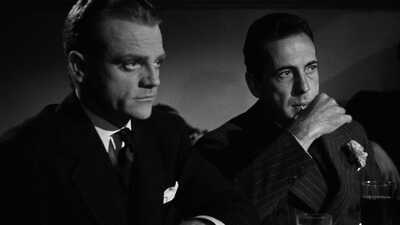By the end of the decade, Hollywood had also figured out a visual film grammar to go with sound. You could feel this happening during moments of the early gangster movies, but the aesthetics of “The Roaring Twenties” and the other milestones of the storied Class of ’39 (including “Gone With the Wind,” “Stagecoach,” and “Mr. Smith Goes to Washington”) are miles ahead in terms of what the camera did and didn’t do in, say, “The Public Enemy.” Take the kinetic, climactic tracking shot executed by Walsh and his cinematographer, Ernest Haller, that guides Eddie down the sidewalk toward his inevitable fall and the epitaph uttered by his fellow down-and-outer, Panama (Gladys George), also ruined by the one-two punch of Prohibition’s end and the Depression’s beginning: “He used to be a big shot.” Walsh always knew how to make movies move, even back in 1915, when he made his first feature, the gangster movie “Regeneration.”
The career trajectories of Walsh, Cagney and Bogart would continue to intersect in fascinating ways. Walsh directed Cagney in “The Strawberry Blonde” (1941), a romantic comedy (with Olivia de Havilland and Rita Hayworth) that still allowed the star to flex some tough guy muscle. The next year Cagney gave his only Oscar-winning performance, as song-and-dance giant George M. Cohan in “Yankee Doodle Dandy.” As the plucky gangster movie was largely supplanted by fatalistic noir, Cagney’s persona and roles took on a more heroic bent. But when he and Walsh reunited for the life of crime, they blew the roof off the genre. “White Heat” (1949) gave us Cagney’s Cody Jarrett, the gangster as psychotic mama’s boy, a feral beast in a fedora. Older and a little heavier that in his “Roaring Twenties” days, Cagney is both hilarious and terrifying in “White Heat,” which is not only a classic gangster movie but also a classic prison movie. The famous, fiery ending—“Made it, Ma! Top of the world!”—feels like an apocalypse of sorts for the gangster movie; in an interview on the Criterion disc, the critic Gary Giddins argues that the genre endured a mid-century fallow period that ended only with “The Godfather” in 1972.

Bogart’s path after “Roaring Twenties” is even more interesting. In 1940, he reteamed with Walsh for “They Drive by Night” and also “High Sierra,” in which he plays Roy Earle, a hardened thief with a soft spot, one of the good bad guys (or bad good guys) that Hellinger liked so much (he’s an associate producer here). Then came the movies that would make Bogart a true star and cement his persona of a cynical romantic not to be trifled with: “The Maltese Falcon” (1941), “Casablanca” (1942), “To Have and Have Not” (1944), and “The Big Sleep” (1946). In none of these movies would Bogart’s character be considered a bad guy, certainly not as bad as the irredeemable scoundrel he plays in “The Roaring Twenties.”

